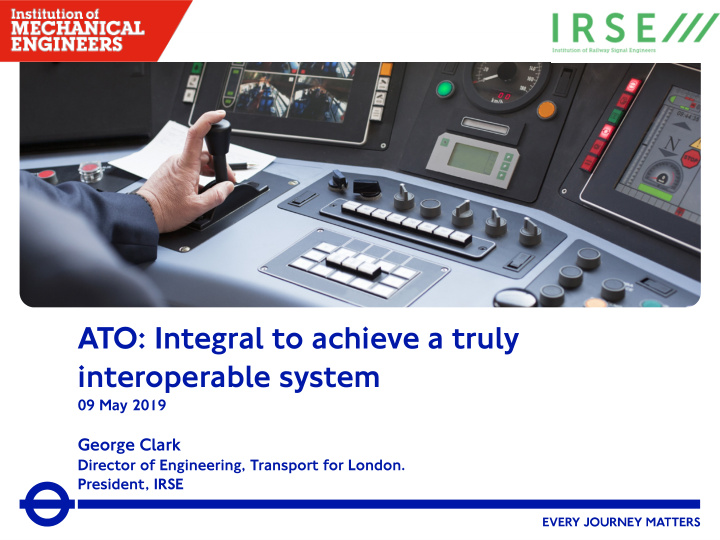



1 ATO: Integral to achieve a truly interoperable system 09 May 2019 George Clark Director of Engineering, Transport for London. President, IRSE
2 ATO: INTEGRATION TO ACHIEVE A TRULY INTEROPERABLE SYSTEM Overview • History of ATO, from beginnings in Mass Transit world • The need to collaborate between the train and the signal • Challenges that face railways implementing ATO • What ATO can unlock for a better future
ATO: INTEGRATION TO ACHIEVE A TRULY INTEROPERABLE SYSTEM Why ATO ?
4 ATO: INTEGRATION TO ACHIEVE A TRULY INTEROPERABLE SYSTEM The beginnings of ATO London Underground Victoria Line The first automatic railway in the • world opened 1 968-1 971 ATO was a showcase of technical • research & innovation but the need was primarily driven by capacity demand (alleviate pressures on the Northern and Piccadilly Lines) Provided the Opportunity for a whole system approach to the railway design Social benefits of railways were first introduced • Every station inter-connect with another line or • national rail (except Pimlico) Humped station platform design to improve • acceleration and braking Cross-platform changes, e.g. at Euston with the • Northern Line, at Finsbury Park with the Piccadilly Line Stimulated the collaboration between different engineering disciplines
5 ATO: INTEGRATION TO ACHIEVE A TRULY INTEROPERABLE SYSTEM The beginnings of collaboration • Examples of rolling stock engineers working together with Signal engineers to deliver the capacity outcome 1967TS Performance Curve Signal Overlap & Command Spots 1960’s ATO architecture
6 ATO: INTEGRATION TO ACHIEVE A TRULY INTEROPERABLE SYSTEM Essential for ATO: systems integration Increasing system complexity means more parts have to work • together to delivery the outcome E-ATO Full Automation. Demand based service Enhanced Service management Control . Auto Dwell Management. Partial Automatic Capacity Full Automatic Train Train Regulation enhancements Regulation Train Management through software ATO Systems for asset Air Conditioned \ ATR management & comms Decision Support Train Cars link to control room. Enhanced electronics & Integrated Signals Integrated Train Auto turnaround SCADA and Comm Systems Identification and Electro mechanical / Comms Systems Tunnel Cooling Relays / Enhanced signalling Integrated Real simple discreet functionality based on Time Information Mobile Phone and component solid state technology Electro/ pneumatic / TV services above electronics Mobile Phone and mechanical/ relays Integrated ticketing DC Cam-shaft controllers and below ground TV services below Basic Automatic and payment systems Automatic Train & motors replaced by AC ground Train Protection Operation drives
Environmental Factors • Need for Train location • Need to lubricate • Vegetation control Automatic Train Operation – Need for Enhanced Adhesion Management
ATO: INTEGRATION TO ACHIEVE A TRULY INTEROPERABLE SYSTEM The benefits of ATO Manual d l driv ivin ing profile iles • Delivers a step-change to capacity and safety • Improves runtime variability • taking out the slack and delivers faster journey times • Maximise acceleration and braking ATO d driv ivin ing p profile iles profiles • improving headway and minimises recovery margins to deliver a higher frequency service • Improves timetable adherence • minimising excess journey times and increase schedule confidence • Opens up the opportunities for wider systems integration, e.g. ATR, TMS • improving journey time reliability and implementing energy efficiency strategies
9 ATO: INTEGRATION TO ACHIEVE A TRULY INTEROPERABLE SYSTEM The challenges with ATO • Acceptance of change • How does the driver know the system is functioning correctly? How do you manage driver under-loading and maintain awareness & concentration? • Training and up-skilling is needed to adapt to the technology and ways of working • Designing to the margin • Minimising safety margins to realise the full capability of the train and infrastructure; otherwise, performance , specifically, at junctions and schedule termini may be worse than manual driving • Sweating the assets • The ability to work the assets harder and at high frequencies creates a new generation of wear and tear, meaning an increased focus on system reliability and maintenance is needed • Climate change • System upgrade and migration • Ensuring the railway continues to operate seamlessly during the period of change is like running a marathon whilst undertaking open-heart surgery
10 ATO: INTEGRATION TO ACHIEVE A TRULY INTEROPERABLE SYSTEM The ATO future • At the heart of a fully integrated railway system ATO Performance analytics Engineering & & scheduling systems design BIG Data & IoT Customer information Operations & service Asset management systems control & maintenance
11 ATO: INTEGRATION TO ACHIEVE A TRULY INTEROPERABLE SYSTEM AI ATO i am aware the performance of passenger door Z80 has been sub-optimal ... initiating diagnosis and filing maintenance report i am experiencing adhesion problems .... optimising traction at 85% and updating scheduling system i am aware the approach platform is at crowded at 95% ... adjusting dwell time and uploading forecast to customer system i am aware communications line x.286 has failed ... initiating diagnosis and back-up system i am aware... Thank You !
Recommend
More recommend